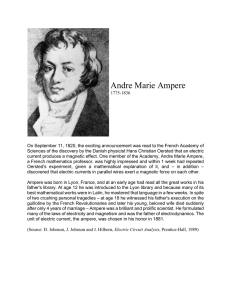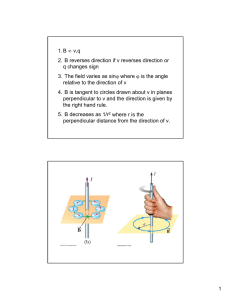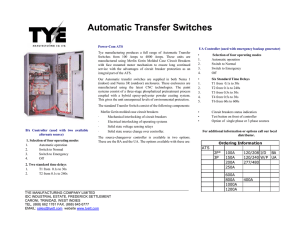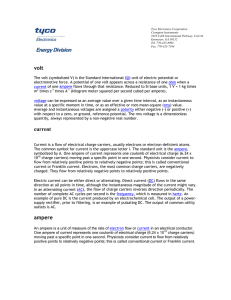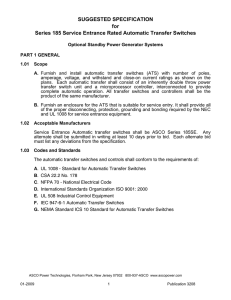381333-127G - Emerson Network Power
advertisement
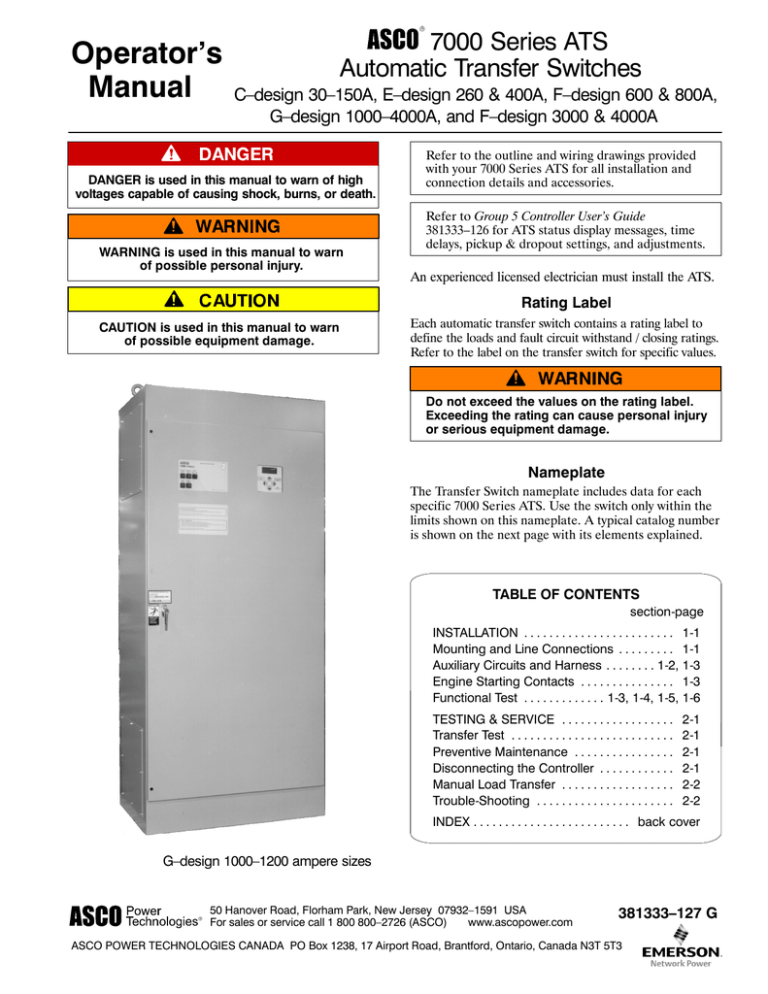
Operator’s Manual 7000 Series ATS Automatic Transfer Switches C–design 30–150A, E–design 260 & 400A, F–design 600 & 800A, G–design 1000–4000A, and F–design 3000 & 4000A DANGER is used in this manual to warn of high voltages capable of causing shock, burns, or death. WARNING is used in this manual to warn of possible personal injury. Refer to the outline and wiring drawings provided with your 7000 Series ATS for all installation and connection details and accessories. Refer to Group 5 Controller User’s Guide 381333–126 for ATS status display messages, time delays, pickup & dropout settings, and adjustments. An experienced licensed electrician must install the ATS. Rating Label CAUTION is used in this manual to warn of possible equipment damage. Each automatic transfer switch contains a rating label to define the loads and fault circuit withstand / closing ratings. Refer to the label on the transfer switch for specific values. Do not exceed the values on the rating label. Exceeding the rating can cause personal injury or serious equipment damage. Nameplate The Transfer Switch nameplate includes data for each specific 7000 Series ATS. Use the switch only within the limits shown on this nameplate. A typical catalog number is shown on the next page with its elements explained. TABLE OF CONTENTS section-page INSTALLATION . . . . . . . . . . . . . . . . . . . . . . . . 1-1 Mounting and Line Connections . . . . . . . . . 1-1 Auxiliary Circuits and Harness . . . . . . . . 1-2, 1-3 Engine Starting Contacts . . . . . . . . . . . . . . . 1-3 Functional Test . . . . . . . . . . . . . 1-3, 1-4, 1-5, 1-6 TESTING & SERVICE . . . . . . . . . . . . . . . . . . Transfer Test . . . . . . . . . . . . . . . . . . . . . . . . . . Preventive Maintenance . . . . . . . . . . . . . . . . Disconnecting the Controller . . . . . . . . . . . . Manual Load Transfer . . . . . . . . . . . . . . . . . . Trouble-Shooting . . . . . . . . . . . . . . . . . . . . . . 2-1 2-1 2-1 2-1 2-2 2-2 INDEX . . . . . . . . . . . . . . . . . . . . . . . . . back cover G–design 1000–1200 ampere sizes 50 Hanover Road, Florham Park, New Jersey 07932–1591 USA For sales or service call 1 800 800–2726 (ASCO) www.ascopower.com 381333–127 G ASCO POWER TECHNOLOGIES CANADA PO Box 1238, 17 Airport Road, Brantford, Ontario, Canada N3T 5T3 Catalog Number Identification Typical 7000 Series catalog no. for G–design solid neutral, 3 pole, 1200 A, 480 V, ATS in Type 1 enclosure: G 7ATS A 3 1200 N 5 C design prefix letter Neutral A – solid B – switched C – overlapping blank – none Phase Poles 2 – single Ø 3 – three Ø Amperes 30 800 70 1000 100 1200 150 1600 260 2000 400 3000 600 4000 Voltage A 115 B 120 C 208 D 220 E 230 F 240 G 277 H 380 J 400 K 415 L 440 M 460 N 480 P 550 Q 575 R 600 Controller Enclosure 5 – standard 5X – if C – type 1 F – type 3R G – type 4 L – type 12 M –type 3R secure N –type 4 secure P –type 4X secure Q –type 12 secure accessories ordered blank – open type field connections terminal block TB ground lug Group 5 Controller power connections Transfer Control & lights Transfer Switch power connections G–design 1200 ampere size in typical enclosure with location of customer connections SECTION 1 INSTALLATION ASCO Series 7000 Automatic Transfer Switches are factory wired and tested. Field installation simply requires mounting and connection of service cables, and auxiliary control circuits (if required). Remove the Shipping Skid (large ATSs) For large ATSs, open the front door and remove the four lag screws (2 in front, 2 in rear) securing enclosure to the wood skid. Supporting Foundation Mount the ASCO ATS vertically to a rigid supporting structure. Level all mounting points by using flat washers behind the holes to avoid distortion of the switch. Transfer switches rated 260 and 400 ampere are mounted on an insulator backing piece (installed behind the transfer switch). If the transfer switch is removed from the cabinet and then reinstalled, this insulator piece must be placed behind the transfer switch. See Figure 1-1. The supporting foundation for the enclosure must be level and straight. Refer to the applicable enclosure outline drawing included with the switch for all mounting details including door opening space. Be sure that the insulator piece is behind the 260 and 400 ampere transfer switches. If bottom cable entry is used, the foundation must be prepared so that the conduit stubs are located correctly. Refer to the enclosure outline drawing for specified area and location. Provide cable bending space and clearance to live metal parts. When a concrete floor is poured, use interlocking conduit spacer caps or a wood or metal template to maintain proper conduit alignment. insulator backing piece Mounting Refer to the Outline and Mounting Diagram provided with the ATS; it shows all mounting details and instructions. Figure 1-1. Insulator for 260 & 400 ampere switches. Protect the switch from construction grit and metal chips to prevent malfunction or shortened life of the automatic switch switch. The controller is mounted on the cabinet door. An add-on DIN rail is provided for some optional accessories and is mounted below the controller on the door. Line Connections A Wiring Diagram is furnished with the ASCO Series 7000 ATS (separate from this manual). Refer to this drawing. All wiring must be made in accordance with the National Electrical Code and local codes. De–energize the conductors before making any line or auxiliary circuitry connections. Be sure that Normal and Emergency line connections are in proper phase rotation. Place engine generator starting control in the OFF position. Make sure engine generator is not in operation. Testing Power Conductors Do not connect the power conductors to the transfer switch until they are tested. Installing power cables in conduit, cable troughs and ceiling-suspended hangers often requires considerable force. The pulling of cables can damage insulation and stretch or break the conductor’s strands. For this reason, after the cables are pulled into position, and before they are connected, they should be tested to verify that they are not defective or have been damaged during installation. 1---1 INSTALLATION (continued) Connecting Power Conductors After the power cables have been tested, connect them to the appropriate terminal lugs on the transfer switch as shown on the wiring diagram provided with the switch. Make sure the lugs provided are suitable for use with the cables being installed. Standard terminal lugs are solderless screw type and will accept the wire sizes listed on the drawings provided with the switch. Be careful when stripping insulation from the cables; avoid nicking or ringing the conductor. Remove surface oxides from cables by cleaning with a wire brush. When aluminum cable is used, apply joint compound to conductors. Tighten cable lugs to the torque specified on rating label. Three cable spacers are included with 150 ampere transfer switches. When installing power cables, run the cables through the cable spacers as shown in Figure 1-2. Position cable spacers within 1½ inches from lugs. Figure 1-3. Barriers on F–design 600 & 800 ampere transfer switches Bus Connections If bus connection is used, use SAE grade 5 hardware to connect bus to appropriate terminal plates on the transfer switch. Wipe off bus surfaces before they are joined. If bus is very dirty, gently clean surfaces with a non–flammable solvent. Avoid touching cleaned surfaces. Do not breathe cleaning solvent vapors. The cable spacers must be located as shown for 150 ampere transfer switches. cable spacers Use SAE grade 5 hardware and tighten the bolted joints to the torque specified in Table A. The reliablility of the connection depends on how clean and how tight the joint is. 1 ½ inch approximate Table A. Tightening torque values for bolted joints. Bolt Diameter (Grade 5 hardware) in inches 5/16 3/8 1/2 5/8 3/4 cable spacer Figure 1-2. Cable spacer for C–design 150 ampere transfer switch Do not run cables behind the switch. Cables can be bundled on the right side of the switch. Maintain proper electrical clearance between the live metal parts and grounded metal: ½ inch minimum for 30-400 ampere, 1 inch minimum over 400 ampere. It is not necessary to remove the barriers from 30–400 ampere transfer switches to install cables. On 600–800 ampere Transfer Switches, you must remove the barriers to install the cables. See Figure 1–3. Be sure to reinstall the barriers carefully. Recommended Tightening Torque in foot pounds 12 20 50 95 155 Controller Ground A grounding wire must be connected to the controller’s lower left mounting stud. Because the controller is mounted on the enclosure door, a conductive strap must be used between the enclosure and the door. This connection provides proper grounding which does not rely upon the door hinges. Harnesses The transfer switch is connected to the left side of the controller by a plug-in harness (two plugs). 1---2 INSTALLATION (continued) Engine Starting Contacts The engine control contact connections (if used) are located on the transfer switch. Connect signal wires to appropriate terminals as specified in Table B and Table C and shown in Figure 1-4 and Figure 1–5. Table B. Engine start connections for C–design 30 – 150 ampere transfer switches When normal source fails contact closes contact opens Terminals on transfer switch TB14 and TB15 TB14 and TB16 engine start connections on customer terminal block TB ENGINE STARTING CONTACTS ( SHOWN DE–ENERGIZED ) TOP STUD 14 MIDDLE STUD 15 BOTTOM STUD 16 TS NR NR TB 14 TB 15 TB 16 Figure 1-4. Engine starting contact label and location for C–design 30 – 150 ampere switches. Table C. Engine start connections for 260 – 4000 ampere transfer switches When normal source fails contact closes contact opens Terminals on transfer switch TB1 and TB2 TB1 and TB3 Figure 1-5. Customer terminal block on the top right side of enclosure on 260–4000 ampere switches. Auxiliary Circuits Connect auxiliary circuit wires to appropriate terminals on the transfer switch. Note the control features that are furnished on this switch. Make the necessary auxiliary connections by referring to the Wiring Diagram. Functional Test The Functional Test consists of three checks: S 1 — Manual Operation Test, page 1–4 S 2 — Voltage Checks, page 1–5 Read all instructions on the Wiring Diagram and labels affixed to the automatic transfer switch. Note the control features that are provided and review their operation before proceeding. S 3 — Electrical Operation, page 1–6 Continue to 1 – Manual Operation Test on next page. Do these checks in the order presented to avoid damaging the ATS. 1---3 INSTALLATION handle (continued) handle handle handle Figure 1-6. 30 – 150 ampere C–design transfer switches Figure 1-7. 260 & 400 ampere E–design transfer switches Figure 1-8 600 & 800 ampere F–design transfer switches 1 – Manual Operation Test 1000 – 4000 ampere G–design See Figure 1-10. Install the hub onto the center operator shaft and insert the manual firmly into the hole in the side of the hub (spring fully compressed). A maintenance handle (detachable on 260–4000 ampere sizes) is provided on the transfer switch for maintenance purposes only. Manual operation of the switch should be checked before it is energized (operated electrically). 3000 and 4000 ampere F–design See Figure 1-9. Insert the manual handle into the hole in the weight. Do not manually operate the transfer switch until both power sources are disconnected: open both circuit breakers. 1. Figure 1-9. 3000 & 4000 ampere F–design transfer switches Select the appropriate switch amperage size / design and follow the directions for installing the handle: 2. Move the handle as shown to manually operate the Transfer Switch. The switch should operate smoothly without binding. If it does not, check for shipping damage or construction debris. 3. Return the transfer switch to the N (normal) position. Remove manual operator handle (if detachable) and store it on the transfer switch in the place provided. 30 – 150 ampere C–design See Figure 1-6. Grasp attached manual handle (left side of the operator) and turn it with thumb and fingers. 260 and 400 ampere E–design See Figure 1-7. Insert the manual handle into the hole in the shaft, left side of the operator. Verify that the maintenance handle has been removed (260–4000 ampere size transfer switches) before proceeding! 600 and 800 ampere F–design See Figure 1-8. Insert the manual handle into the hole in the weight. Now continue to 2 – Voltage Checks on next page. Emergency contacts window indicators Grasp handle firmly with both hands Turn counterclockwise to Emergency. Turn clockwise to Normal. Insert handle into hole (spring fully compressed) Slide hub onto shaft OPEN or CLOSED Normal contacts contact position indicators (left side) counterclockwise DOWN closes the Emergency source contacts (upper) and opens the Normal source contacts (lower) clockwise DOWN closes the Normal source contacts (lower) and opens the Emergency source contacts (upper) Figure 1-10. 1000 – 4000 ampere G design transfer switches. 1---4 INSTALLATION GREEN RED GREEN RED (continued) observe these lights Figure 1-11. Standard controls and indicators. 2 – Voltage Checks First check nameplate on transfer switch; rated voltage must be the same as normal and emergency line voltages. Close the normal source circuit breaker. The Transfer Switch 1 Connected To Normal and the Normal Source Accepted lights should come on. Use an accurate voltmeter to check phase to phase and 2 phase to neutral voltages present at the transfer switch normal source terminals. Verify that the feeders have been connected to the proper lugs. Close the emergency source circuit breaker. (Start generator, if necessary.) The Transfer 3 Switch Connected To Normal & Emergency Source Accepted lights should come on. Use extreme caution when using a meter to measure voltages. Do not touch power terminals; shock, burns, or death could result ! Perform steps 1 through 6 at the right. Observe the status lights. See Figure 1–11. Use an accurate voltmeter to check phase to phase and 4 phase to neutral voltages present at the transfer switch emergency source terminals.* Q Black square means light is on. S White square means light is off. * If necessary, adjust voltage regulator on the generator according to the manufacturer’s recommendations. The Automatic Transfer Switch will respond only to the rated voltage specified on the Transfer Switch nameplate. Use a phase rotation meter to check phase rotation of emer5 gency source; it must be the same as the normal source. Shut down the engine–generator, if applicable. The Emergency Source Accepted light should 6 go off. Then put the starting control selector switch (on the generator set) in the automatic position. Close enclosure door. Note Refer to Section 3 of Group 5 Controller User’s Guide 381333–126 for how to display the Status of the ATS and the Voltage and Frequency of each source. Now continue to 3 – Electrical Operation on next page. 1---5 A B C INSTALLATION GREEN RED GREEN RED (continued) operate this switch observe these lights Figure 1-12. Standard controls and indicators. 3 – Electrical Operation The Transfer Switch Connected 1 To Normal and Normal Source Accepted lights should be on. This procedure will check the electrical operation of the Automatic Transfer Switch. See Figure 1–12. Turn and hold Transfer Control switch clockwise to Transfer Test until the engine starts 2 and runs (within 15 sec.). Emergency Source Accepted light should come on. Be sure to close the enclosure door before proceeding to prevent personal injury in case of electrical system fault. Transfer switch will operate to the Emergency position after Feature 2B time delay. The 3 Transfer Switch Connected To Emergency light should come on and Load Connected to Normal light goes off. Transfer switch will operate back to Normal position after Feature 3A time delay. For immediate retransfer turn Transfer Control counterclockwise to 4 Retransfer Delay Bypass. The Transfer Switch Connected To Normal light should come on; Transfer Switch Connected to Emergency light should go off. Transfer Test Both normal and emergency sources must be available and the emergency source generator (if used) must be capable of being started in this procedure. Perform steps 1 through 5 at the right. Observe the status lights. Q Black square means light is on. S White square means light is off. The engine–generator will stop after the Feature 2E time delay 5 (unloaded running engine cooldown). The Emergency Source Accepted light should go off. This completes the Functional Test of the ATS. 1---6 SECTION 2 TESTING & SERVICE TRANSFER TEST DISCONNECTING THE CONTROLLER Operate the 7000 Series ATS at least once a month by following the five–step Electrical Operation Transfer Test procedure on page 1–6. The harness disconnect plugs are furnished for repair purposes only and should not have to be unplugged. If the controller must be isolated, follow these steps: Disconnecting the Plugs PREVENTIVE MAINTENANCE Reasonable care in preventive maintenance will insure high reliability and long life for the 7000 Series ATS. An annual preventive maintenance program is recommended. Do not unplug the controller until steps 1a or 1b is completed. 1. Observe the position of the transfer switch. ASCO Services, Inc. (ASI) is ASCO Power Technologies’s national service organization. ASI can be contacted at 1-800-800-2726 for information on preventive maintenance agreements. a. If the transfer switch is in the Normal position, first place standby engine starting control in the off position. Second, then open the emergency source circuit breaker. Third, open the normal source circuit breaker. Checklist for Yearly Inspection b. If the transfer switch is in the Emergency position, first open the normal source circuit breaker. Second, place the engine starting control in the test or run position. Third, open the emergency source circuit breaker. Hazardous voltage capable of causing shock, burns, or death is used in this switch. Deenergize both Normal – Emergency power sources before performing inspections! 2. Separate the two quick disconnect plugs by squeezing the latches. Do not pull on the harness wires. S Clean the ATS enclosure. Brush and vacuum away any excessive dust accumulation. Remove any moisture with a clean cloth. Reconnecting the Plugs S Check the transfer switch contacts. Remove the Do not unplug the controller until steps 1a or 1b is completed. transfer switch barriers and check contact condition. Replace the contacts if they become pitted or worn excessively. Reinstall the barriers carefully. 1. Observe the position of the transfer switch. S Maintain transfer switch lubrication. If the a. If the transfer switch is in the Normal position, first be sure that both normal and emergency source circuit breakers are open. Second, be sure that the standby engine starting control is still in the off position. transfer switch is subjected to severe dust or abnormal operating conditions, renew factory lubrication on all movements and linkages. Relubricate the solenoid operator if the TS coil is replaced. Do not use oil; order lubrication 625550–001 (Castrol EndurexR 4000 lubricant) for 30–400 amp., or order lubrication kit 75-100 for 600–4000 amp. size. b. If the transfer switch is in the Emergency position, first be sure that both normal and emergency source circuit breakers are open. 2. The two harness plugs and sockets are keyed. Carefully align the plugs with the sockets and press straight in until both latches click. Close the door! S Check all cable connections & retighten them. REPLACEMENT PARTS 3. Restore the two sources in sequence as follows: Replacement parts are available in kit form. When ordering parts provide the Serial No., Bill of Material No. (BOM), and Catalog No. from the transfer switch nameplate. Contact your local ASCO Power Technologies Sales Office or ASI: a. If the transfer switch is in the Normal position, first close the normal source circuit breaker. Second, close the emergency source circuit breaker. Third, place the standby engine starting control in the automatic position. In the United States call 1 – 800 – 800 – ASCO ( 2726 ) b. If the transfer switch is in the Emergency position, first close the emergency source circuit breaker. Second close the normal source circuit breaker. 2---1 TESTING & SERVICE MANUAL LOAD TRANSFER (continued) 2. Use the maintenance handle to manually operate the transfer switch to the opposite source. See Manual Operation on page 1–4. This procedure will manually transfer the load if the controller is disconnected. 3. Then remove the maintenance handle. See page 1–4. Do not manually operate the transfer switch until both power sources are disconnected (all conductors deenergized). Verify that the maintenance handle has been removed before proceeding! 1. Deenergize both the normal and emergency source conductors (remove fuses or open circuit breakers). 4. If the transfer switch is in the Emergency position manually start the engine generator and then install emergency source fuse or close the circuit breaker. TROUBLE-SHOOTING Note any optional accessories that may be furnished on the automatic transfer switch (ATS) and review their operation. Refer to any separate drawings and/or instructions that may be packed with the ATS. Hazardous voltage capable of causing shock, burns, or death is used in this switch. Do not touch the power or load terminals of the transfer switch! Table 2-1. Trouble-Shooting Checks. PROBLEM Engine–generator set does not start when the Transfer Control switch is turned and held in Transfer Test position or when the normal source fails. CHECK IN NUMERICAL SEQUENCE 1 2 OPERATION GEN-SET Hold Transfer Test switch 15 Starting control must be in the seconds or the outage must automatic position. Batteries be long enough to allow for must be charged and Feature 1C time delay plus connected. Check wiring to engine cranking and starting engine starting contacts on time. customer terminal block TB. Verify that the small plug J3 is connected to receptacle P3. Transfer switch does not transfer the load to the emergency source after the engine–generator set starts. Wait for Feature 2B time delay Generator output circuit to time out (if used). breaker must be closed. Generator frequency must be at least 95% of nominal (57 Hz for a 60 Hz system.) * Transfer switch does not transfer the load to normal source when normal returns or when the Transfer Control switch is released. Wait for Feature 3A time delay to time out (if used). Engine–generator-set does not stop after load retransfer to the normal source. Wait for Feature 2E time delay Starting control must be in the to time out (if used). automatic position. – 3 VOLTAGE – Voltmeter should read at least 90% of nominal phase to phase voltage between transfer switch terminals EA and EC (or EL1 and EL2 for 2 pole switches). * Voltmeter should read at least 90% of nominal phase to phase voltage between transfer switch terminals NB and NC, NC and NA, and NA and NB (or NL1 and NL2 for 2 pole switches). – * These are factory settings. Refer to the Group 5 Controller User’s Guide. If the problem is isolated to circuits on the controller or the transfer switch, call your local ASCO Power Technologies sales office or ASI: in the United States, call 1–800–800–2726. Furnish the Serial No., Catalog No., and Bill of Material (BOM) No. from the transfer switch nameplate. 2---2 INDEX A auxiliary circuits, 1–3 B barriers, 1–2 C cable lugs, 1–2 preparation, 1–2 spacers, 1–2 illustration of, 1–2 I inspection, 3–1 installation, 1–1 insulator backing piece, 1–1 illustration of, 1–1 warning, 1–1 L cleaning, 2–1 connections line, 1–1 lights, 1–5, 1–6 contact position indicators, 1–4 controller, 1–1, 1–2 disconnecting, 2–1 see Controller User’s Guide grounding, 1–2 E electrical operation, 1–6 Emergency Source Accepted light, 1–5, 1–6 F lubrication, 2–1 M maintenance, preventive, 3–1 manual load transfer, 3–2 warning, 3–2 manual operation, 1–4 illustration of, 1–4 warning, 1–4 P parts, 2–1 phase rotation check, 1–5 R rating label, cover S settings see Controller User’s Guide T test, functional, 1–3, 1–4, 1–5, 1–6 time delays, 2–1 see Controller User’s Guide Transfer Control selector switch Retransfer Delay Bypass, 1–6 Transfer Test, 1–6 Transfer Switch Connected to Emergency light, 1–5, 1–6 Transfer Switch Connected to Normal light, 1–5, 1–6 transfer test, 1–6 transfer to emergency, 1–6 functional test, 1–3, 1–4, 1–5, 1–6 N harness, 1–2 disconnect plugs, 2–1 nameplate, cover help customercare@asco.com 800–800–ASCO Normal Source Accepted light, 1–5, 1–6 Printed in U.S.A. optional accessories see Controller User’s Guide replacement parts, 2–1 frequency, generator, 2–2 H operation electrical, 1–6 manual, 1–4 illustration of, 1–4 warning, 1–4 sequence of, 2–1 problem, 2–2 labels, engine start contacts, 1–3 rating, cover catalog number, inside cover O transfer to normal, 1–6 trouble–shooting, 2–2 V voltage checks, 1–5 voltage, pickup and dropout settings see Controller User’s Guide Copyright 2009 ASCO Power Technologies, L.P.
